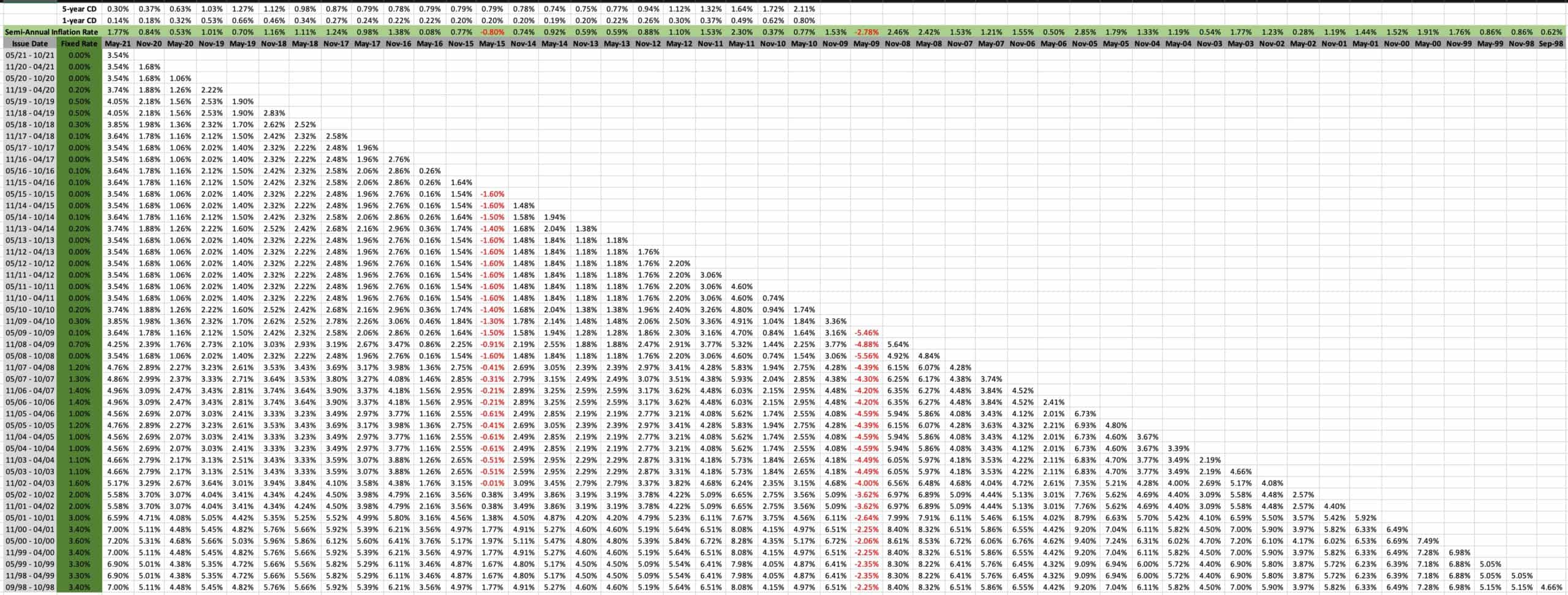[ad_1]
I get loads of questions on cash. These questions are likely to differ based mostly on the asker and her wants, however there’s one query I get extra typically than some other: “What’s a safe investment with a excessive return?”
For the previous decade or so, I’ve had no reply to this query. Financial savings accounts and certificates of deposit are protected, certain, however they’re now not enticing investments. For the reason that Nice Recession of 2008/2009, rates of interest have remained shockingly low. That is by design. The federal government does not need you parking your cash in a financial savings account. They need that cash out circulating within the financial system.
Over the long term, the stock market offers excellent returns. However when persons are asking for “protected” investments, they’re wanting keep away from short-term volatility, which suggests shares are out of the query. (And stuff like Bitcoin and treasured metals are much more out of the query!)
In the present day, nonetheless, whereas catching up on my weblog studying, I stumbled upon a link from Michael Kitces’ weekly roundup for financial planners. The story he shared blew my thoughts. Writing in The Wall Road Journal, Jason Zweig explains the safe, high-return trade hiding in plain sight. (This text is behind a paywall.) That protected, high-return commerce? U.S. authorities Collection I financial savings bonds.
These inflation-adjusted bonds are at present yielding 3.54% yearly!
Zweig writes:
Economists say there’s no such factor as a free lunch, however I bonds provide a assure from the U.S. authorities you can get better your unique capital plus any will increase within the official value of dwelling alongside the best way. The one catch is that this isn’t an all-you-can-eat buffet: The utmost buy is $10,000 per 12 months per account holder (except you have chose to take your tax refund within the type of an I bond).
Mockingly, the much less you earn and have to speculate, the extra highly effective a software I bonds are.
As a result of I used to be unfamiliar with I Bonds, I spent a few hours studying about them as we speak. I feel I will start including them to my funding portfolio. You would possibly prefer to additionally. Let me share what I’ve discovered.
The Fundamentals of I Bonds
Collection I financial savings bonds (or just “I Bonds”) are inflation-indexed bonds with a variable rate of interest. That variable fee includes two elements.
- A hard and fast fee. On the primary enterprise day in Could and the primary enterprise day in November, the U.S. Treasury adjusts this fastened fee for brand new bonds. However as soon as you buy a Collection I bond, this fastened fee by no means modifications. If the fastened portion of your I Bond is 2.10% if you buy it, it will stay 2.10% for thirty years (or till you promote it).
- A variable fee listed to inflation. This fee additionally adjusts at first of Could and November. It is based mostly on modifications to the Client Worth Index. Presently, the “semiannual inflation fee” (because it’s formally recognized) is 1.77%, which interprets right into a 3.54% annual fee.
The fastened fee and variable fee elements are added collectively to generate the present composite rate of interest. As a result of inflation can go destructive (a.okay.a. deflation), the variable fee may go destructive. When that occurs, the present yield in your I Bonds can fall under the fastened fee. Nevertheless, curiosity on these bonds can by no means yield under zero. They’ll by no means lose worth.
Curiosity compounds each six months. I Bonds are exempt from state and native taxes, however they’re topic to federal revenue tax once they’re redeemed.
Does that each one sound sophisticated? It isn’t, actually.
Whenever you purchase a Collection I bond, you lock in your fastened fee. Then, each six months, the variable fee adjusts based mostly on inflation.
Presently, the fastened fee on Collection I financial savings bonds is zero %. In truth, the fastened fee has remained under one % on all Collection I bonds issued since Could 2008. Why then would you think about including them to your portfolio? As a result of regardless of the low fastened fee, this stuff nonetheless out-earn financial savings accounts and certificates of deposit.
Now, having stated that, money you set into these bonds is lots much less liquid than the cash you set into the financial institution.
- You should maintain the bond for at the very least one 12 months. You completely can not redeem a Collection I bond till it’s twelve months outdated.
- You’ll be able to redeem the bond after one 12 months. But when you have not held the bond for at the very least 5 years, you lose the newest three months of accrued curiosity.
There are a few different drawbacks you could find out about. First, you possibly can solely purchase I Bonds electronically from Treasury Direct. (That is an official U.S. authorities website, so it is protected. Or must be.) Second, you are solely allowed to buy $10,000 of I bonds annually.
Did I say “solely”? I lied. Kind of. You are additionally allowed to purchase I Bonds with your income tax refund. Doing so lets you purchase as much as $5000 extra in I Bonds annually. And bonds bought this manner are paper bonds, not digital.
There are different minor stuff you would possibly need to find out about these funding autos. If you would like extra information, take a look at the official Series I Savings Bond FAQ. (And you may also like this table comparing I Bonds to TIPS, Treasury inflation-protected securities.)
I Bonds by the Numbers
As a result of I am a cash nerd — and since I used to be curious — I created a spreadsheet that paperwork historic Collection I bond yields since they had been launched in September 1998. (That is based mostly on the official table from Treasury Direct, however I’ve made it prettier and straightforward to replace sooner or later.)
This can be a large spreadsheet, so it will be unreadable right here on this display screen. You will need to open the picture in a brand new tab. (Clicking on the picture ought to try this for you.) Even then, you could must manually re-adjust the picture measurement to have the ability to learn it.
Here is easy methods to learn this spreadsheet.
- Every row tracks the rate of interest on Collection I bonds issued for dates in that vary. For instance, the “05/08 – 10/08” row tracks how the rate of interest has modified on bonds issued between Could and October of 2008. The primary quantity in every row (the “fastened fee” within the inexperienced column) reveals the everlasting fastened fee for the bonds issued throughout that point interval. For the “05/08 – 10/08” bonds, that fastened fee was 0.00%.
- Every column tracks semi-annual modifications to rates of interest. The Treasury adjusts charges on (or quickly after) Could 1st and November 1st. The highest line of every column reveals the official inflation fee used to calculate complete bond yields. So, you possibly can see that the “Could-08” column signifies that the semi-annual inflation fee was 2.42% (that means annual inflation was 4.84%), and the remainder of the column reveals efficient charges for varied bonds.
- I’ve additionally tried to compile historic information on common certificates of deposit charges. I have never discovered a supply I belief and love for this information, although, so am open to suggestions. (I might additionally prefer to discover a supply for historic financial savings account information. I have been trying to find years and have by no means discovered something I like.)
Taking a look at this spreadsheet, you possibly can see that I Bonds do not all the time outperform five-year certificates of deposit — however they often do. And there have been a few events when even a one-year CD has supplied a greater yield for a couple of months.
The Backside Line
I’ve by no means bought a financial savings bond. That is about to vary.
I like the concept of utilizing I Bonds as a automobile for medium-term investing — saving for a home, saving for faculty schooling, and many others. In case your time horizon is longer than 5 years however shorter than, say, fifteen years, these are a lovely possibility, particularly if it is cash you can not afford to lose. Proper now, I like them higher than a financial savings account or CD!
For longer time horizons, and for cash with which you’ll take larger danger, you are higher off investing in index funds. Collection I bonds will not earn as a lot as shares over the long term. Not based mostly on historic averages, anyhow. However that is not the purpose. These bonds aren’t meant for rising your nest egg. They’re meant to maintain your nest egg protected.
Even when these do not attraction to you now, you need to control Collection I bonds to see the place their fastened charges go. In the event that they creep as much as the three-percent vary (as they did 20+ years in the past), they are a terrific deal.
Replace: Chris Mamula at Can I Retire But? simply revealed an article that compares two inflation-protected authorities bonds: Series I Bonds vs. TIPS. Helpful information there, if this kind of funding pursuits you.
[ad_2]
Source link





